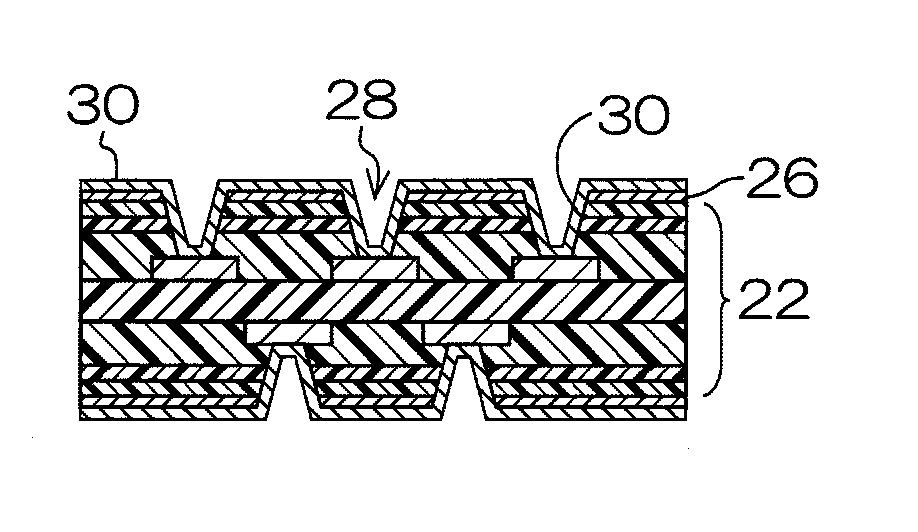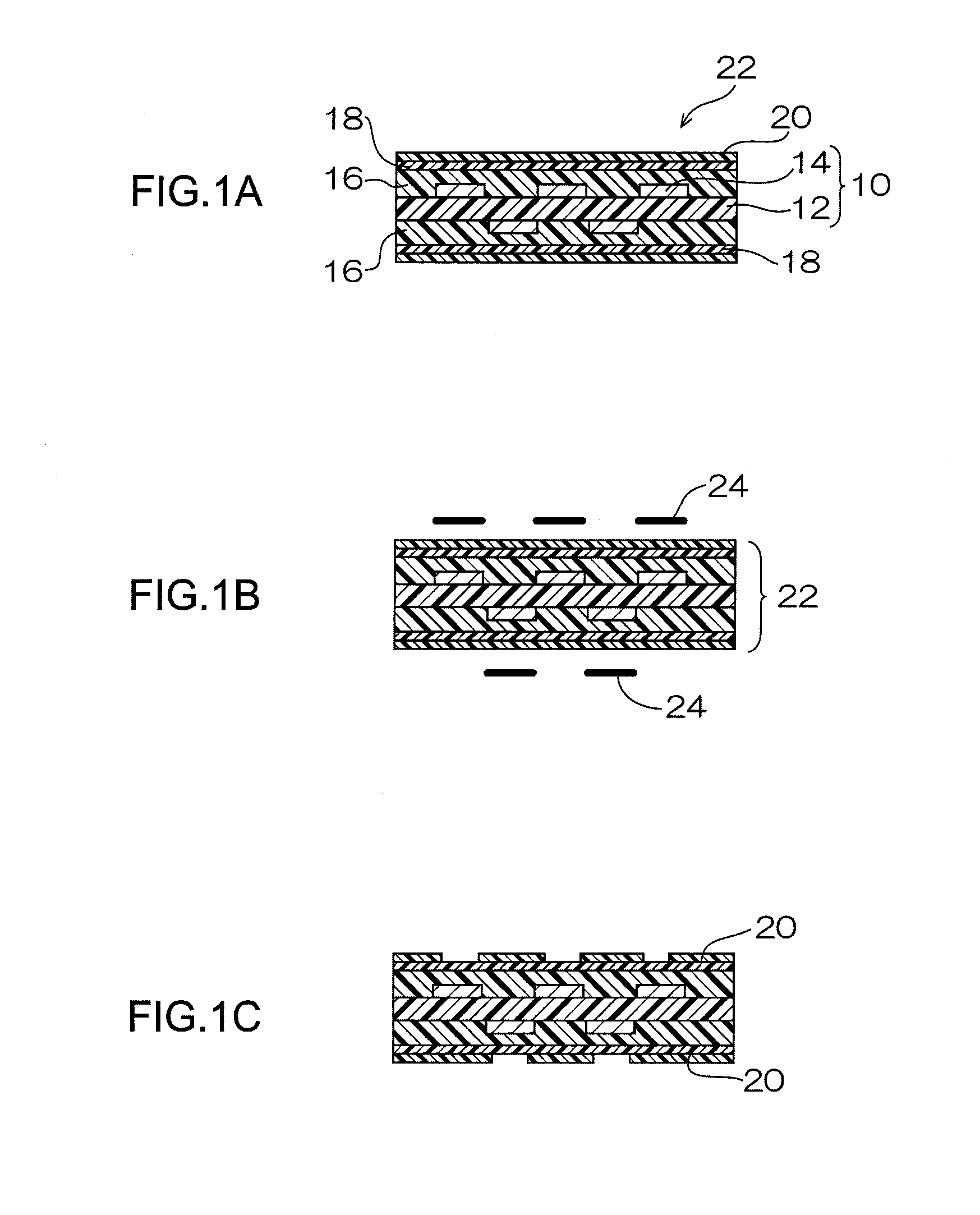Method for producing multilayer wiring substrate and multilayer wiring substrate
- Summary
- Abstract
- Description
- Claims
- Application Information
AI Technical Summary
Benefits of technology
Problems solved by technology
Method used
Image
Examples
example 1
[0325]Preparation of Core Substrate
[0326]An insulating resin layer 16 was formed by attaching, as an electrically insulating layer, an epoxy-based insulating film (GX-13, trade name, manufactured by Ajinomoto Fine-Techno Co., Inc., thickness: 45 μm), to a glass epoxy substrate 12 on which a first wiring 14 was previously formed by a vacuum laminator, and heating and pressing under the conditions of temperature: 100 to 110° C. and pressure: 0.2 MPa.
[0327]Formation of Adhesion Auxiliary Layer
[0328]A coating liquid was prepared by mixing 11.8 parts by mass of JER 806 (bisphenol F-type epoxy resin, trade name, manufactured by Japan Epoxy Resins Co., Ltd.), 4.8 parts by mass of LA 7052 (PHENOLITE, trade name, curing agent, manufactured by DIC Corporation), 21.7 parts by mass of YP 50-35 EK (phenoxy resin, trade name, manufactured by Tohto Kasei Co., Ltd.), 61.6 parts by mass of cyclohexanone, and 0.1 part by mass of 2-ethyl-4-methyl imidazole (curing promotor), and then filtering the mix...
example 2
[0365]In order to produce a multilayer wiring substrate of an embodiment in which the inside of the via is filled with a metal by plating Preparation of a multilayer wiring substrate was conducted in a manner substantially similar to that in Example 1, except that the conditions of the above electroplating were changed to the following conditions.
[0366]Composition of Electroplating Bath
Copper (II) sulfate pentahydrate280gConcentrated sulfuric acid35gHydrochloric acid0.15mLCU-BRITE VF-II A (trade name, manufactured by 28.56mLEbara Udylite Co., Ltd.)CU-BRITE VF-II B (trade name, manufactured by1.46mLEbara Udylite Co., Ltd.)Distilled water1400g
[0367]Electroplating was conducted for 50 minutes under the condition of 2 A / dm2. The thickness of the obtained electric copper plated film was 20 μm.
[0368]When plating was conducted under the above conditions, the inside of the via was filled with copper.
[0369]Evaluation of Multilayer Wiring Substrate
[0370]The fine wiring thus formed was evaluat...
example 3
[0372]Preparation of a multilayer wiring substrate was conducted in a manner substantially similar to that in Example 1, except that, the conditions of the desmear treatment was changed in a manner such that the immersion in the etchant at a temperature of 80° C. for 10 minutes in Example 1 was changed to immersion in the etchant at a temperature of 75° C. for 5 minutes. Each Ra of the via-portion and the wiring portion was measured, and it was revealed that Ra of the via-portion was 0.39 μm, Ra of the second wiring portion was 0.08 μm, and the ratio of Ra of the second wiring portion to Ra of the inner face of the via-portion was 0.21. The formation of wiring could be conducted until the line / space reached 8 μm / 8 μm, and when the wiring form was observed, it was revealed that the shape of the edge portion of the wiring was a straight line. Furthermore, it was found that peeling off, floating, or the like did not occur at the wiring portion.
PUM
| Property | Measurement | Unit |
|---|---|---|
| Thickness | aaaaa | aaaaa |
| Thickness | aaaaa | aaaaa |
| Percent by volume | aaaaa | aaaaa |
Abstract
Description
Claims
Application Information
 Login to View More
Login to View More - R&D
- Intellectual Property
- Life Sciences
- Materials
- Tech Scout
- Unparalleled Data Quality
- Higher Quality Content
- 60% Fewer Hallucinations
Browse by: Latest US Patents, China's latest patents, Technical Efficacy Thesaurus, Application Domain, Technology Topic, Popular Technical Reports.
© 2025 PatSnap. All rights reserved.Legal|Privacy policy|Modern Slavery Act Transparency Statement|Sitemap|About US| Contact US: help@patsnap.com



